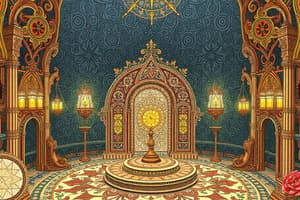Podcast
Questions and Answers
What is the notation that describes elements using a rule?
What is the notation that describes elements using a rule?
- Intersection notation
- Roster notation
- Set-builder notation (correct)
- Union notation
What is the term for a collection of unique objects?
What is the term for a collection of unique objects?
- Element
- Set (correct)
- Member
- Union
What is the term for fractions that have the same value but different numerators and denominators?
What is the term for fractions that have the same value but different numerators and denominators?
- Ordered fractions
- Simple fractions
- Complex fractions
- Equivalent fractions (correct)
What is the result of combining all elements from two sets?
What is the result of combining all elements from two sets?
How do you compare fractions with different denominators?
How do you compare fractions with different denominators?
What is the term for the bottom number of a fraction?
What is the term for the bottom number of a fraction?
What is the process of reducing a fraction to its simplest form?
What is the process of reducing a fraction to its simplest form?
Flashcards are hidden until you start studying
Study Notes
Set Theory
- A set is a collection of unique objects, called elements or members.
- Sets can be represented using roster notation (listing elements inside curly brackets {}) or set-builder notation (describing elements using a rule).
- Union of two sets: all elements from both sets combined (e.g., A ∪ B).
- Intersection of two sets: elements common to both sets (e.g., A ∩ B).
- Complement of a set: all elements not in the set (e.g., A' or U - A).
Comparing Fractions
- A fraction represents a part of a whole, consisting of a numerator (top number) and a denominator (bottom number).
- Equivalent fractions have the same value, but different numerators and denominators (e.g., 1/2 = 2/4).
- To compare fractions, follow these steps:
- Convert both fractions to have the same denominator (find the least common multiple, LCM).
- Compare the numerators; the fraction with the larger numerator is larger.
- Ordering fractions from least to greatest: arrange fractions in ascending order (e.g., 1/4, 1/2, 3/4).
- Simplifying fractions: divide both numerator and denominator by their greatest common divisor (GCD) to reduce the fraction to its simplest form.
Studying That Suits You
Use AI to generate personalized quizzes and flashcards to suit your learning preferences.




